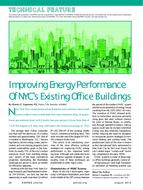Heat networks can be an effective way of supplying low carbon heat to buildings. Current UK systems are largely based on fossil fuel Combined Heat and Power (CHP). Such systems are unlikely to be acceptable in the long term, if the decarbonisation targets in the UK are to be attained. As the UK’s electricity grid eventually becomes cleaner, heat pumps could provide an alternative environmental friendly heat supply. Heat networks are best suited to areas with high heat demand density such as big cities. Within these urban settings, heat is potentially more easily accessible through alternative sources. This paper investigates Underground Railways (UR) as an attractive year-round heat source. Air source recovery through the ventilation system of a railway has been shown to have significant potential. However, the soil surrounding a typical deep level UR tunnels also contain a large amount of heat. This low grade energy could potentially be extracted by nearby users through Ground Source Heat Pumps (GSHP). In order to fully explore and exploit this potential resource, the interactions of GSHPs with neighbouring URs requires understanding. This paper presents numerical investigations into the interactions between these systems.
Citation: 2017 Winter Conference, Las Vegas, NV, Conference Papers
Product Details
- Published:
- 2017
- Number of Pages:
- 8
- Units of Measure:
- Dual
- File Size:
- 1 file , 820 KB
- Product Code(s):
- D-LV-17-C001


